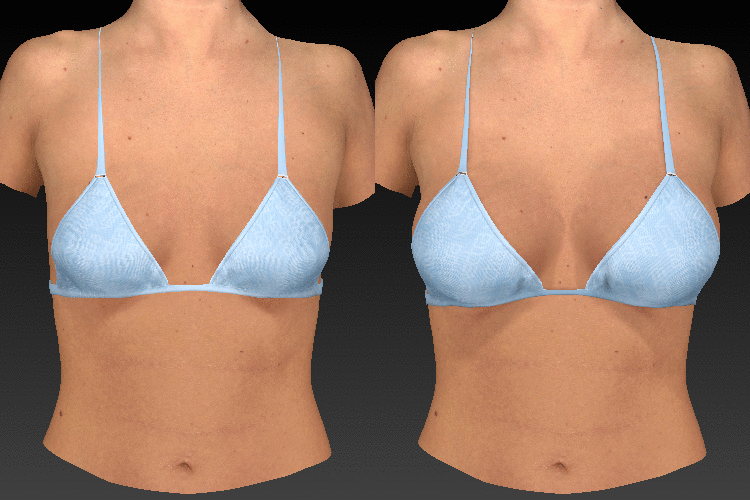
What to Expect after Surgery
After breast enlargement surgery, you will be placed in a surgical bra to hold breasts in place during the healing process and minimise post-operative bruising. Oral pain medications will help to keep you comfortable during the first 48 hours after your procedure. Most patients are able to return to activities within one week, although more strenuous exercise will likely be restricted for much longer.
Breast implants produce an immediate increase in breast fullness. The breasts may appear overly full at first due to post-operative swelling, but this should settle over time. Some women keep the same implants for a lifetime. However, implants are not designed to last forever, and some patients need to replace or remove their implants in a secondary procedure.
Breast augmentation is a highly personal choice, which is why Dr Thomas will handle your experience with discretion and sensitivity. He will walk you carefully through each decision and step of the process to ensure you are fully informed about your options. To learn more about your choices in breast enlargement, contact Dr Thomas on 03 9034 7738 to schedule your private consultation.
Risks and Complications of Breast Augmentation
Complications can arise after breast augmentation. Some of the risks and adverse outcomes of breast implant surgery include:
- Breast pain
- Asymmetry
- Changes in skin or nipple sensation
- Chest wall deformity
- Capsular contracture
- Rupture and deflation
- Malposition/displacement
- Delayed wound healing or infection
- Additional surgeries (with or without removal of the implant)
- Breast implant associated-anaplastic large cell lymphoma (BIA-ALCL)
Activity Guidelines After Breast Augmentation Surgery
Post-operative instructions are targeted to minimise the risks outlined above. Recovery time can vary depending on the individual and the extent of the surgery, but the following is a general timeline for the breast augmentation recovery process:
Guidelines:
Days 1-3
- After the surgery, you will be monitored in a recovery room for a few hours to ensure that there are no complications. You will then be allowed to go home.
- Expect some discomfort, bruising and swelling around your breasts and chest.
- Avoid all activities that increase heart rate or blood pressure and anything that could contaminate the surgical incision.
- Starting immediately after surgery, you will be required to wear a compression vest for several weeks under your clothing. This is to assist with swelling and wound healing.
Days 4-7
- From day 3, resume walking at a leisurely pace.
- It is important to avoid sweating and excessive shoulder movement as you resume light activities, especially overhead and sideways movements.
- 1 week: Many patients can return to work.
- 1 week onwards: Driving is okay as long as you feel safe and able to do so.
Weeks 2-3
- 2 weeks: If you have not already returned to work, you will likely now be able to do so.
- 3 weeks: Resume light lower body resistance training and stationary cycling.
- 3 weeks: Avoid any activities that could contaminate the incisions, such as hot tubs/spas and pools, until completely healed.
Weeks 4-6
- 4 weeks: Gentle shoulder stretching may resume (only if you do not experience pain when doing it).
- 6 weeks: Jogging, running and road cycle activities are acceptable.
Weeks 7 and Beyond
- 12 weeks: You can resume all activities, but listen to your body and use discomfort or tightness as a guide so you don’t overdo it.
Breast Augmentation Results
The results of breast augmentation typically take a few weeks to appear as the breasts heal, the swelling subsides and the implants settle to their final position. Your full results may not be apparent for several months after the procedure.
The longevity of breast augmentation results varies from person to person, depending on factors such as the type of implant, the surgical technique and the patient’s lifestyle. Breast implants are not considered permanent, and they may require replacement at some point. However, with proper care and maintenance, breast implants can often last for years.
To ensure that the results of your breast augmentation last as long as possible, follow your surgeon’s post-operative instructions carefully and attend follow-up appointments as directed. Additionally, a healthy lifestyle that includes a balanced diet, regular exercise and avoiding smoking can help you maintain the results of your breast augmentation over time.
A Note on Results
The results of any medical treatment, aesthetic or otherwise, will affect patients differently based on various individual, genetic, environmental, diet, exercise and other factors. For that reason, you should always expect to see some variance between the results featured and the results you can achieve. What works for one person may not work for another, and each patient’s unique needs and expectations must be considered when determining the best course of action.
Therefore, it is essential to have a thorough consultation with a qualified and experienced medical professional who can help to determine the most appropriate treatment plan based on your specific circumstances. It is also important to understand that breast augmentation is not a quick fix and requires patience and commitment to achieve the desired results.

